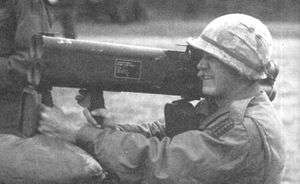M202 FLASH
| Launcher, Rocket, 66mm, 4-Tube, M202 | |
|---|---|
 | |
| Type | Multishot incendiary rocket launcher |
| Place of origin | United States |
| Service history | |
| Used by | See Operators |
| Production history | |
| Designed | 1970s |
| Produced | 1978 |
| Variants | M202, M202A1 |
| Specifications | |
| Weight |
11.5 lb (5.22 kg) empty 26.6 lb (12.07 kg) loaded |
| Length |
27 in (686 mm) closed 34.75 in (883 mm) extended |
|
| |
| Cartridge | M235 Incendiary TPA |
| Caliber | 2.6 in (66 mm) |
| Action | Single shot (each rocket has its own firing pin) |
| Muzzle velocity | 375 ft/s (114 m/s) |
| Effective firing range | 22 yd (20 m) minimum |
| Maximum firing range |
820 yd (750 m) (area target) 219 yd (200 m) (point target) |
| Feed system | 4 rocket clip[1] |
| Sights | Reflex |
The M202 FLASH (FLame Assault SHoulder Weapon) is an American rocket launcher, designed to replace the World War II–vintage flamethrowers (such as the M1 and the M2) that remained the military's standard incendiary devices well into the 1960s. The M202 is based on the prototype XM191 napalm rocket launcher that saw extensive testing in the Vietnam War.
Description
The M202A1 features four tubes that can load 66 mm incendiary rockets. The M74 rockets are equipped with M235 warheads, containing approximately 1.34 pounds (0.61 kg) of an incendiary agent. The substance, often mistaken for napalm, is in fact TPA (thickened pyrophoric agent).
TPA is triethylaluminum (TEA) thickened with polyisobutylene. TEA, an organometallic compound, is pyrophoric and burns spontaneously at temperatures of 1200 °C (2192 °F) when exposed to air. It burns "white hot" because of the aluminum, much hotter than gasoline or napalm. The light and heat emission is very intense and can produce skin burns from some (close) distance without direct contact with the flame, by thermal radiation alone.
The M202 was designed to share its 66mm caliber with the contemporary M72 LAW antitank rocket launcher, to allow it to be used as an antitank launcher. While HEAT rounds were trialled with the XM191 launcher under the designation XM78, no HEAT clips were ever manufactured for the M202. Similarly, a crowd control agent round using CS gas, the XM96, was trialled, but never entered service.
The weapon is meant to be fired from the right shoulder, and can be fired from either a standing, crouching, or prone position. It is loaded with a clip which holds a set of four rockets together, which is inserted into the rear of the launcher and can be pushed past the launching position to enable the launcher to be carried while loaded more easily.

The M202A1 was rated as having a 50% chance of hit against the following targets at the noted ranges, assuming all four rockets were fired at the same time:
- Bunker aperture: 50 meters
- Window: 125 meters
- Weapons position or stationary vehicle: 200 meters
- Squad-sized troop formation: 500 meters
The M202A1 was issued as needed, generally one per rifle platoon, although the headquarters of rifle companies were authorized nine M202A1s. As with most RPGs, no dedicated gunners were trained, the weapon instead being carried in addition to the rifleman's standard weapon. While vastly more lightweight than the M2 flamethrower it replaced, the weapon was still bulky to use and the ammunition suffered from reliability problems. As a result, the weapon had mostly been relegated to storage by the mid-1980s, even though it nominally remains a part of the U.S. Army arsenal.
The M202A1 has been among weapons listed on the inventory of U.S. units in the War in Afghanistan.[2]
Operators

Current operators
See also
Notes
- ↑ TC 23-2 66 mm Rocket Launcher M202A1. US Army Manual, April 1978 (via Scribd)
- ↑ Hambling, David (May 15, 2009). "U.S. Denies Incendiary Weapon Use in Afghanistan". Wired.com. Accessed 27 May 2010.
References
- US Army Manual, April 1978 (via Scribd)
- TM 3-1055-456-12 M202A1 Operator's Manual.
- U.S. Patent 4,230,509: Pyrophoric flame composition
External links
| Wikimedia Commons has media related to M202. |
- Image of the XM191 in testing at Footnote Viewer (footnote.com)
- M202A1 Flame Assault Shoulder Weapon (Flash) at Gary's U.S. Infantry Weapons Reference Guide]
- 66 mm Incendiary Rocket M74 at Designation Systems
- TC 23-2 66 mm Rocket Launcher M202A1—US Army Manual, April 1978 (via Scribd)
- M202 FLASH grenade launcher / flamethrower at Modern Firearms
- M202 FLASH on Youtube
- This Rocket Launcher Was the U.S. Army’s Last Flamethrower War is Boring